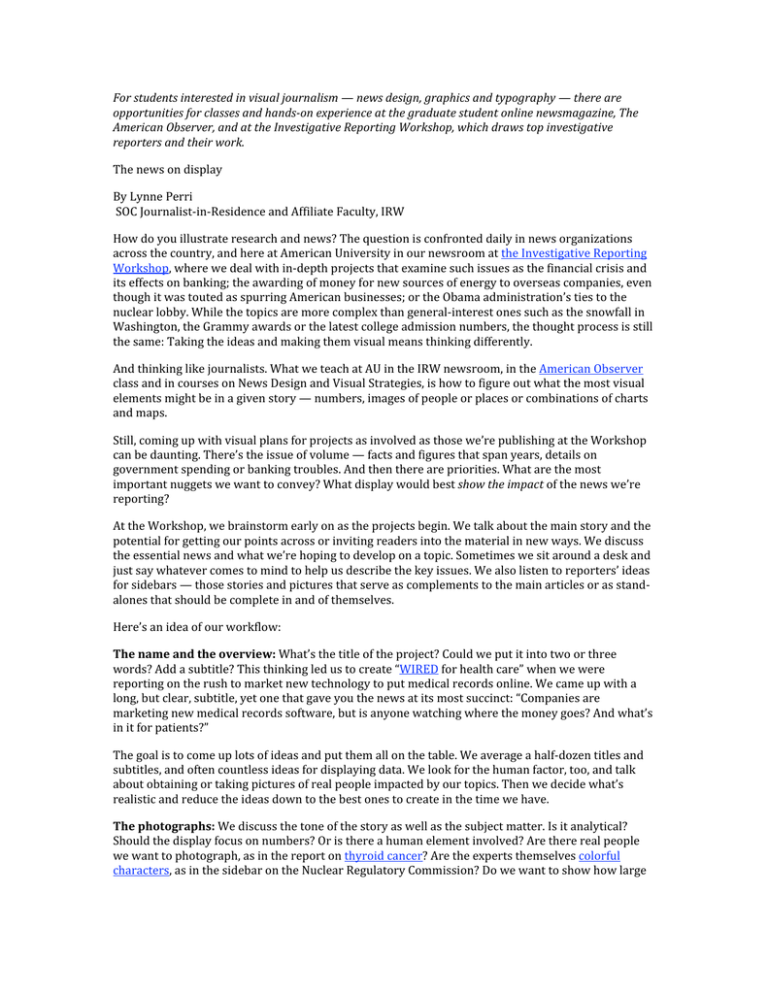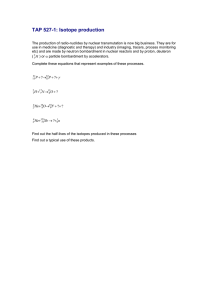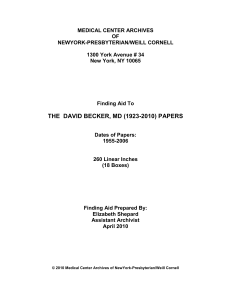For students interested in visual journalism — news design, graphics and typography — there are opportunities for classes and handson experience at the graduate student online newsmagazine, The
advertisement

For students interested in visual journalism — news design, graphics and typography — there are opportunities for classes and hands­on experience at the graduate student online newsmagazine, The American Observer, and at the Investigative Reporting Workshop, which draws top investigative reporters and their work. The news on display By Lynne Perri SOC Journalist‐in‐Residence and Affiliate Faculty, IRW How do you illustrate research and news? The question is confronted daily in news organizations across the country, and here at American University in our newsroom at the Investigative Reporting Workshop, where we deal with in‐depth projects that examine such issues as the financial crisis and its effects on banking; the awarding of money for new sources of energy to overseas companies, even though it was touted as spurring American businesses; or the Obama administration’s ties to the nuclear lobby. While the topics are more complex than general‐interest ones such as the snowfall in Washington, the Grammy awards or the latest college admission numbers, the thought process is still the same: Taking the ideas and making them visual means thinking differently. And thinking like journalists. What we teach at AU in the IRW newsroom, in the American Observer class and in courses on News Design and Visual Strategies, is how to figure out what the most visual elements might be in a given story — numbers, images of people or places or combinations of charts and maps. Still, coming up with visual plans for projects as involved as those we’re publishing at the Workshop can be daunting. There’s the issue of volume — facts and figures that span years, details on government spending or banking troubles. And then there are priorities. What are the most important nuggets we want to convey? What display would best show the impact of the news we’re reporting? At the Workshop, we brainstorm early on as the projects begin. We talk about the main story and the potential for getting our points across or inviting readers into the material in new ways. We discuss the essential news and what we’re hoping to develop on a topic. Sometimes we sit around a desk and just say whatever comes to mind to help us describe the key issues. We also listen to reporters’ ideas for sidebars — those stories and pictures that serve as complements to the main articles or as stand‐ alones that should be complete in and of themselves. Here’s an idea of our workflow: The name and the overview: What’s the title of the project? Could we put it into two or three words? Add a subtitle? This thinking led us to create “WIRED for health care” when we were reporting on the rush to market new technology to put medical records online. We came up with a long, but clear, subtitle, yet one that gave you the news at its most succinct: “Companies are marketing new medical records software, but is anyone watching where the money goes? And what’s in it for patients?” The goal is to come up lots of ideas and put them all on the table. We average a half‐dozen titles and subtitles, and often countless ideas for displaying data. We look for the human factor, too, and talk about obtaining or taking pictures of real people impacted by our topics. Then we decide what’s realistic and reduce the ideas down to the best ones to create in the time we have. The photographs: We discuss the tone of the story as well as the subject matter. Is it analytical? Should the display focus on numbers? Or is there a human element involved? Are there real people we want to photograph, as in the report on thyroid cancer? Are the experts themselves colorful characters, as in the sidebar on the Nuclear Regulatory Commission? Do we want to show how large something is? We did this with a photo of the enormous wind turbines being trucked in from the loading docks in New England to accompany our story on wind energy. In talking through our options journalistically, we’re able to find ideas visually. We can decide on one or two telling photos, as we did for the story of jobs relating to the wind turbine industry going overseas. Or we can decide on multiple still photos or video, as we did for our report on the unexplained increase in thyroid cancer diagnoses. In that package, we featured patients telling how they discovered their thyroid problems and how they treated them. And in our latest investigation on nuclear lobbying, we created a photo gallery of key Congressional players. The informational graphics: Many of our stories involve following the money, which means we need to show such things as how lobbying efforts have grown over time. We create fever or trend lines, as we did in the nuclear energy story. Other stories need comparison charts to show such things as which firms and companies got the money, as we did in the story about wind energy. Sometimes we need maps, and sometimes they need to be interactive, as you see here for the nuclear energy project. Other times, a flat map works, as did this one for nuclear energy as well. Several projects involve tables created from extensive databases, as you’ll find in the Banktracker project. What all these visuals have in common is an attempt to explain the news in alternative ways.




